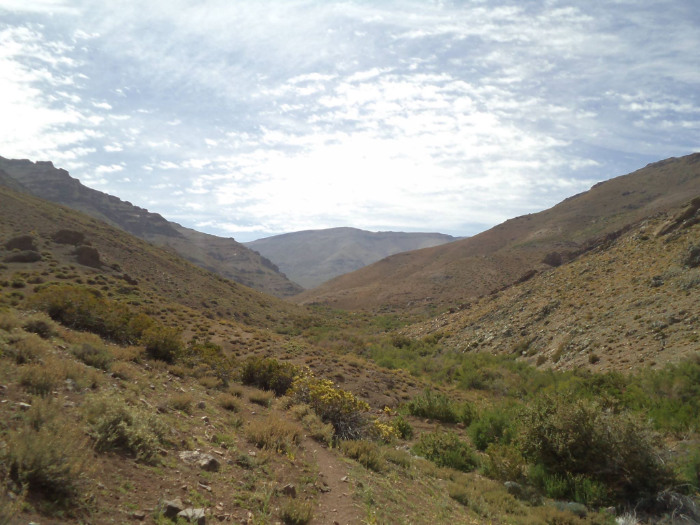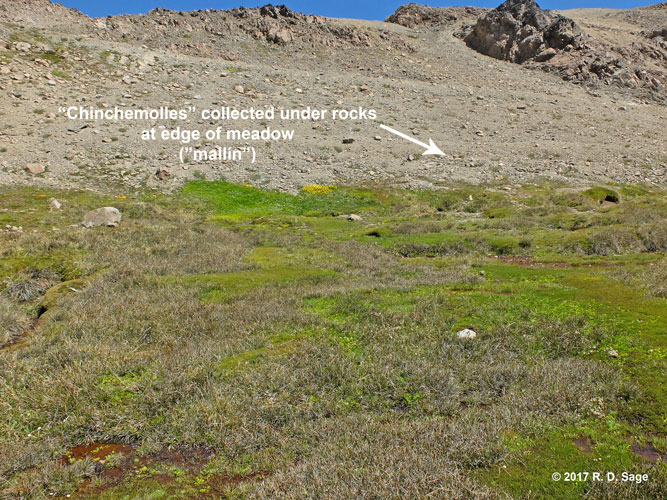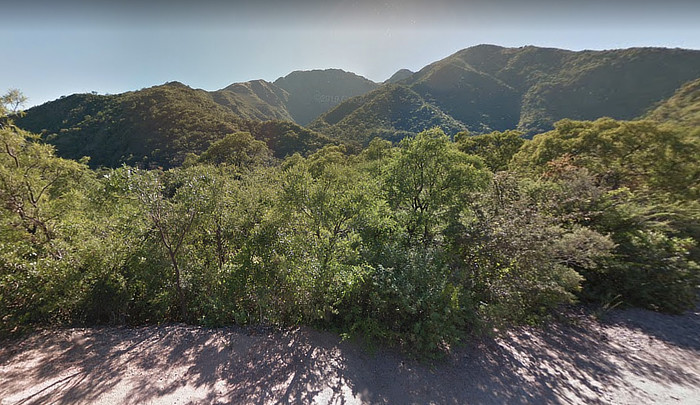
Basically there are two different types Agathemera habitats. One such habitat is chracterized by a sparse vegetation in a semi-arid or even arid environment. Such environments can be found high up in the andean mountains and in the dry patagonian plains of central and southern Argentina . Typically such barren habitats have quite a harsh temperature regime. Due to the sparse vegetation the sun warms the ground up quickly and strongly, while temperatures can fall quite low during winter, sometimes even during summer. In such habitats Agathemera are known to hide out during the day in crevices under rocks and stones. There they are protected at least to some extend against the pronounced temperature fluctuations. Rock can store thermal energy quite well, though it heats up slowley and then emits the heat rather slowey too. Such sparse environments seem to be typical for Agathemera.
Cubillos et al. have measured the soil temperature in Farellones, a natural habitat for Agathemera crassa near Santiago (Chile), at an altitude of 2400 masl1). Their examination revealed that summer temperatures can raise up to 60°C, while during late spring and early autumn temperatures falls below 0°C, with the lowest measured temperature at -6°C. Winter soil temperatures were found to be around 0°C, as the ground is effectively insulated by a thick layer of snow. Even during summer they found that temperatures regularely drop down low, occationally even to sub-zero values.

Yet some Agathemera populations live in areas with a richer vegetation with bushes and trees, like in lowland areas in Chile and rather well-vegetated highland areas of Chile and Argentina. The richer vegetation curbs the extend of temperature fluctuation effectively. Nevertheless, as these areas are located in southern south america they are also exposed to a pronounced seasonal temperature change, including a seasonal change in vegetation and . Examples for such populations are a yellow-banded A. cf. elegans population near Concepción (Chile), populations of A. elegans on the western border of the Andean Range and a A. luteola population from Capilla del Monte (Argentina).
Being able to tolerate these temperature conditions and even to hibernate is an important capability for Agathemera. Either to survive harsh temperature conditions or to avoid a reduced supply of food plants during winter. R.D. Sage has informed me, that he has even observed Agathemera feeding at night in a cold and slightly snow covered area in southern Argentina (Patagonia).
When breeding Agathemera here in Europe, all we can offer are substitute food plants. So far all the substitute food plants we found to support healthy Agathemera cultures are just summer green. And the females, which hatch in spring, will be adult by August or September only. And then there is not much time for them left to lay eggs, as their substitute food plants won't be available anymore due to the approaching winter. Therefore there is a need for breeders, to find a way to hibernate their Agathemera safely and for a long time of about 6 months. Without such a hibernation technique, all the Agathemera specimens will be lost in late autumn.

We have tested different hibernation approaches, with decreasing temperatures levels. The test subjects were Agathemera luteola "Capilla del Monte". This is an interesting population, as they occur in a quite well-vegetated area with rather moderate winter temperatures. If we can find a suitable hibernation technique for this population, then this technique will be (most probably) also be good enough for Agathemera populations from a much harsher environment:
- the first experiment was conducted in a "wine cooler", which only reaches down to about 8 - 12°C. In such a wine cooler, we have kept several adult Agathemera luteola "Capilla del Monte" in a sand covered plastic cricket box for about 3 months (November 2017 to February 2018). During these 3 months, we observed that they were still active in their box. They roamed around, passed faeces and the adult females even laid a few eggs in the sand. After 1.5 months, all individuals were still alive. Then after 3 months, only two individuals (out of 6) were still alive - an adult female and an adult male. The female was already very weak, and died some days later. But the male was still very agile. Their food plants was not available at that moment of the year, and they would not accept any of the winter-green plants offered. Thus he died of starvation, but survived for another two weeks! See the care sheet of Agathemera luteola "Capilla del Monte" for more detailed informations. The conclusion is, that to hibernation Agathemera for a long time, lower hibernation temperatures than 8°C are needed
- the second experiment was conducted in a commercial fridge, where temperatures of about 2 - 4°C were maintained. Again we have kept several subadult and adult Agathemera luteola "Capilla del Monte" specimens (8 in total) in a covered plastic cricket box for up to 5 months (November 2019 to March 2020). These were 8 specimens in total - 2 adult females, 4 adult males and 2 subadult females.They have regularely been inspected, and even after 3 months all individuals still seemed to be alive and healthy. We observed that they were no more active in their box. Neighter did they move around, nor did they pass faeces and the females did not lay any eggs. The only sign of activity was that they were waving their antennae when the box was opened. Then after 5 months, in late march, most specimens were dead. The only ones to survive were a subadult female and an adult male. While they were still alive, they would not start to feed on any of the plants available at that time. Their well accepted food plant was still not available at that time. See the care sheet of Agathemera luteola "Capilla del Monte" for more detailed informations. The conclusion is that lower temperatures seem to successfully extend the hibernation time they can survive. But the hibernation duration of 5 months is still too short, as their well accepted substitute food plants (Rhus, Cotinus) are not available for a duration of about 6 - 6.5 months. Thus the hope remained that even lower hibernation temperatures will help to hibernate Agathemera successfully here in Europe. But would they survive even sub-zero temperatures?
Literature:
- Cubillos et al. (2018). Cold tolerance mechanisms of two arthropods from the Andean Range of Central Chile: Agathemera crassa (Insecta: Agathemeridae) and Euathlus condorito (Arachnida: Theraphosidae). Journal of Thermal Biology. 74. 10.1016/j.jtherbio.2018.03.018.